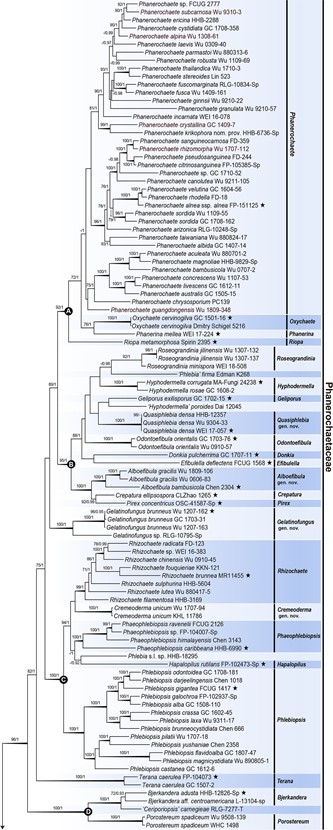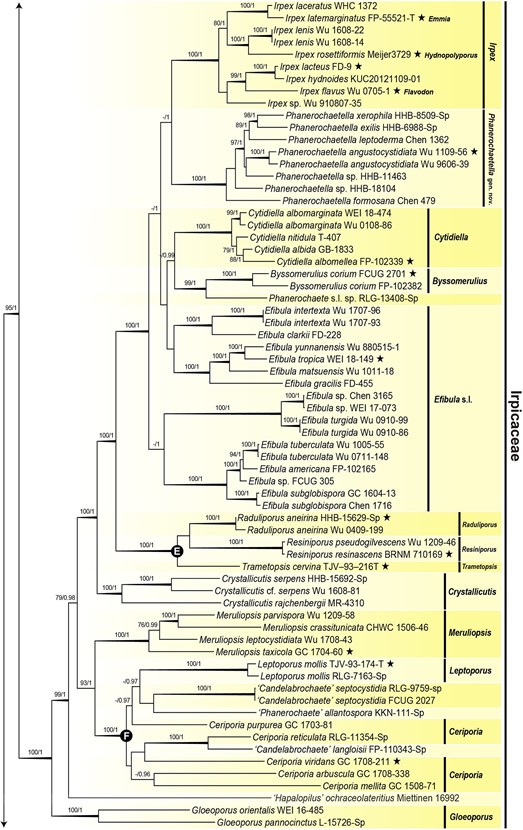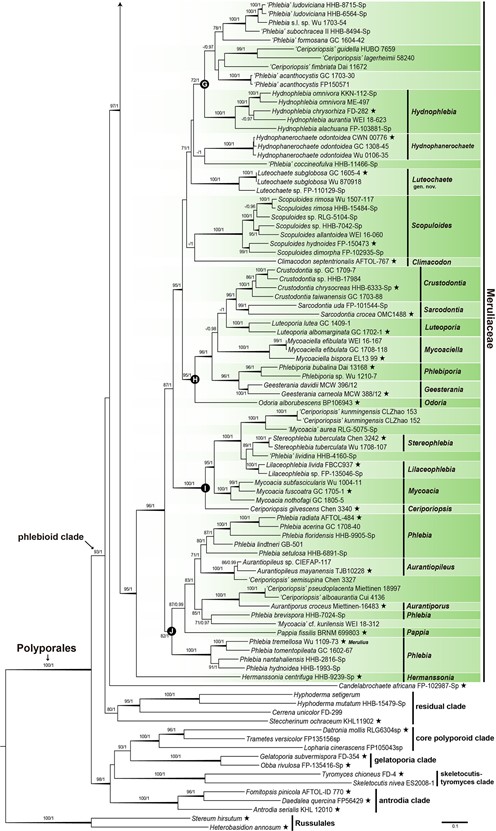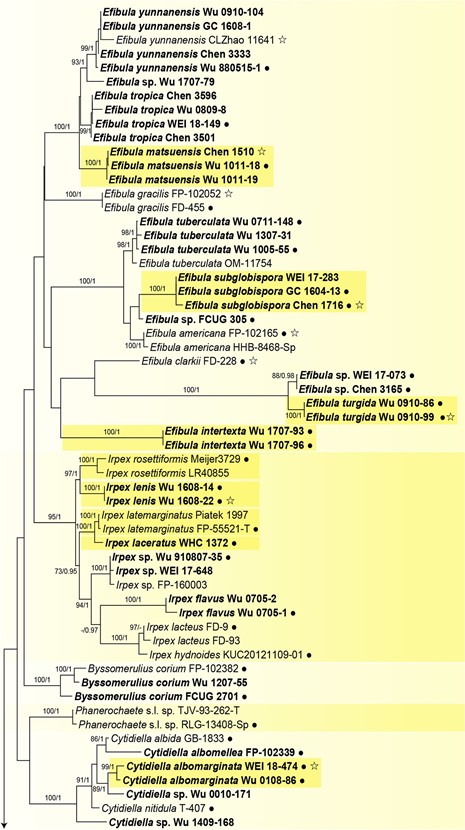Phanerochaetella C.C. Chen & Sheng H. Wu, gen. nov. Fig. 41
MycoBank number: MB 840777; Index Fungorum number: IF 840777; Facesoffungi number: FoF;
Type species: Phanerochaetella angustocystidiata (≡ Phanerochaete angustocystidiata).
Etymology: phanerochaetella (Lat.), referring to the resemblance with the genus Phanerochaete in morphology.
Description: Basidiocarps resupinate, effused, adnate, membranaceous to coriaceous. Hymenial surface white, cream to yellowish, not changing in KOH, smooth to tuberculate. Hyphal system monomitic; generative hyphae simple-septate, rarely with single or double clamp connections. Subiculum uniform or composed of a basal layer with dense to compact texture; hyphae colorless, thin- to thick-walled; hyphal anastomosis variably present. Cystidia lacking or present; when present, usually heavily encrusted with colorless crystals, cylindrical, narrowly cylindrical or subulate, thick- walled (called lamprocystidia here). Cystidioles or hyphidia variably present. Basidia short clavate, clavate to narrowly clavate, 4-sterigmate. Basidiospores ellipsoid, broadly ellipsoid or cylindrical, colorless, thin-walled, smooth, inamyloid, nondextrinoid, acyanophilous. Causing a white rot on angiosperm or gymnosperm wood.
Notes: – In our analyses, the genus Phanerochaetella, equal to the lineage five in Floudas and Hibbett (2015), was resolved as monophyletic with strong support, with species from East Asia, New Zealand, North America, and one new species (P. formosana) from Taiwan (Figs. 1, 5). Phanerochaetella is characterized by having yellowish cream and membranaceous basidiocarps with smooth-tuberculate hymenophore, a subiculum of fairly dense to compact texture, and ordinarily simple-septate hyphae. Cystidia may be absent or present (usually strongly encrusted). However, the above morphological features can also be found in Efibula, Phanerochaete s.s., Phaeophlebiopsis and Phlebiopsis. It is not possible to recognize Phanerochaetella merely based on morphological data.

Fig. 1 The phylogram of the phlebioid clade (Phanerochaetaceae, Irpicaceae, Meruliaceae) of Polyporales inferred from ML analyses using the combined ITS + 28S + rpb1 + rpb2 + tef1 dataset. Branches are labelled with ML BS ≥ 70% and PP ≥ 0.9 from Bayesian analyses. Thicken branches indicated both ML BS ≥ 95% and PP ≥ 0.99 from Bayesian analyses. Line- ages labeled A–J represent the Phanerochaete, Donkia, Phlebiopsis, Bjerkandera, Trametopsis, Ceriporia, Hydnophlebia, Sarcodontia, Mycoacia and core Phlebia lineages, respectively. Black stars (★) represent for strains of generic type species. Bar = substitutions per site

Fig. 1 (Continued)

Fig. 1 (Continued)

Fig. 5 The phylogram of Irpicaceae inferred from ML analyses using the combined ITS + 28S dataset. Branches are labeled with ML boot- strap ≥ 70% and BPPs ≥ 0.9 from Bayesian analyses. New combinations or newly described taxa are shown in yellow boxes. White stars (✰) represent for holotype. Black circles (●) represent for strains included in the 5-gene dataset. Sequences newly generated in this study were shown in bold. Bar = substitutions per site

Fig. 41 Basidiocarps of Phanerochaetella species in general and detailed views. a P. angustocystidiata (Wu 9606-39, holotype). b P. formosana (Chen 3468, holotype). c P. leptoderma (Wu 880405-13, holotype). Bars = 10 mm
